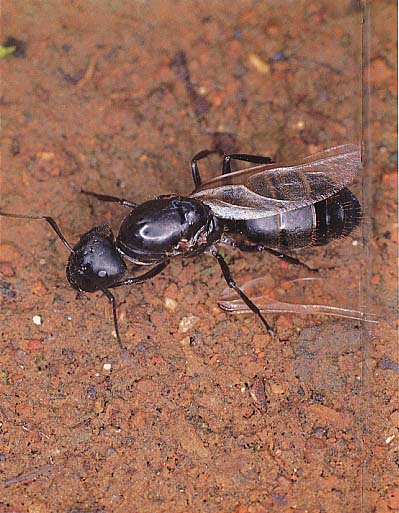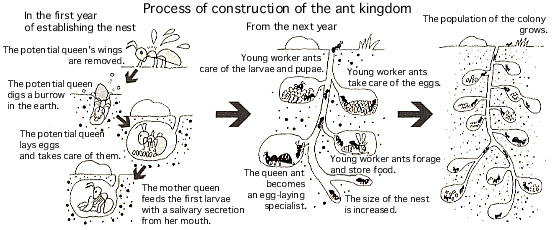|
|
 A potential
queen mates with a male and lands within 30 minutes of the time she leaves
her home nest. Soon after the marriage flight, the potential queen's wings
fall off or she pulls them off. Subsequently, she begins to search for
a satisfactory nest site. Wings have now become useless. A potential
queen mates with a male and lands within 30 minutes of the time she leaves
her home nest. Soon after the marriage flight, the potential queen's wings
fall off or she pulls them off. Subsequently, she begins to search for
a satisfactory nest site. Wings have now become useless.
By the way, do you know that the Camponotus japonicus ant kingdom is
founded by a single female ant?
|
|
|
|
On finding a suitable location for a nest, the potential queen ant begins
to excavate in the earth, for example, under a stone with her mandibles.
When she has dug a small burrow, she encloses herself within it, completely
closing the opening, then she begins egg-laying at the pace of one egg
per day.
After her eggs hatch into larvae, the queen ant rears the first brood
of her larvae without eating any food. The queen feeds the first brood
of larvae with a salivary secretion from her mouth. Not surprisingly,
the larvae are inadequately fed, so that the young adult worker ants of
this first brood are usually small for their species.
From the next year, the queen can become a specialist in laying eggs,
because the first workers care for her eggs, nurse her larvae, forage,
and take care of most other necessities of the colony. In addition, the
workers expand the first small burrow constructed by the young into an
intricate network of chambers, or galleries, and connecting tunnels.
In this way, an ant kingdom is constructed by a specialist ant that lays
eggs the queen ant) and many workers.
|
|
|
 Crafty
female ants Crafty
female ants
Female ants of the Formica sanguinea and Lasius flavus species do not
establish their nests by themselves. After mating, a newly fertilized
potential queen ant of these species works her way into a nest of another
species or, in some cases, of her own species. The intruding queen ant
may associate with the foreign species of ant and kill the host queen
to become the new queen of the nest.
Such intrusion produces a mixed colony containing workers of both a relatively
small number of intruder ants and a relatively large number of host ants.
However, as the host workers die, they are not replaced as their queen
is dead, and eventually the colony consists entirely of ants of the intruder
species.
|
|
![]()
![]()
![]()
![]() Ant
kingdom
Ant
kingdom![]() Structures
of ants
Structures
of ants![]() Winged
ants
Winged
ants![]() Marriage
flight
Marriage
flight![]() Ant
Kingdom from a queen
Ant
Kingdom from a queen![]() Egg-laying
by a queen
Egg-laying
by a queen![]() Ants
are strong
Ants
are strong![]() Procession
of ants
Procession
of ants![]() Ants
like sweets
Ants
like sweets![]() Ants
raising insects
Ants
raising insects![]() Slave-making
ants
Slave-making
ants![]() A
fight of ants
A
fight of ants![]() Ant
lion
Ant
lion![]() Hibernation
of ants
Hibernation
of ants![]() How
to raise ants
How
to raise ants![]() Contents
Contents![]() index
index
 A potential
queen mates with a male and lands within 30 minutes of the time she leaves
her home nest. Soon after the marriage flight, the potential queen's wings
fall off or she pulls them off. Subsequently, she begins to search for
a satisfactory nest site. Wings have now become useless.
A potential
queen mates with a male and lands within 30 minutes of the time she leaves
her home nest. Soon after the marriage flight, the potential queen's wings
fall off or she pulls them off. Subsequently, she begins to search for
a satisfactory nest site. Wings have now become useless.

 Crafty
female ants
Crafty
female ants